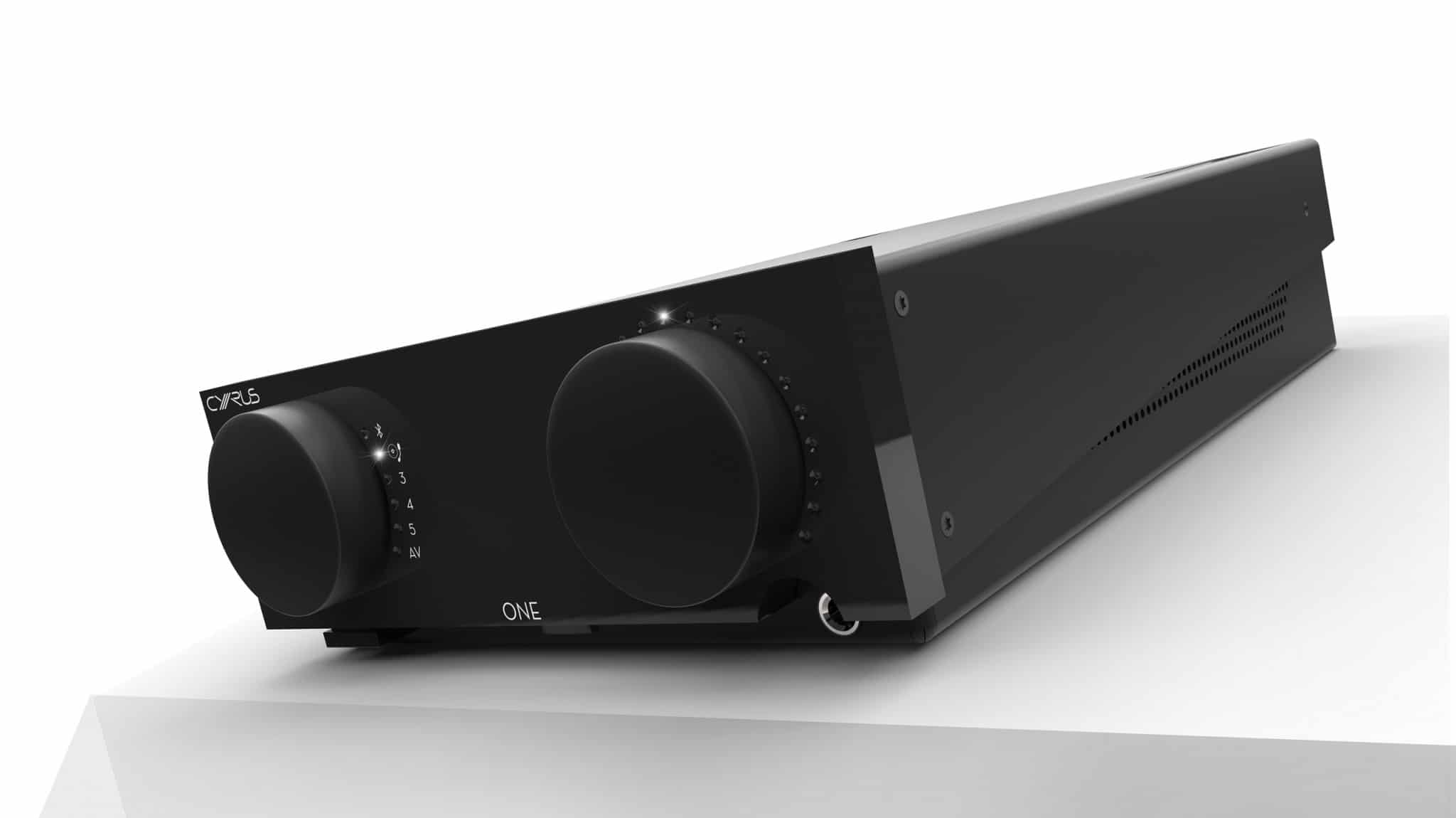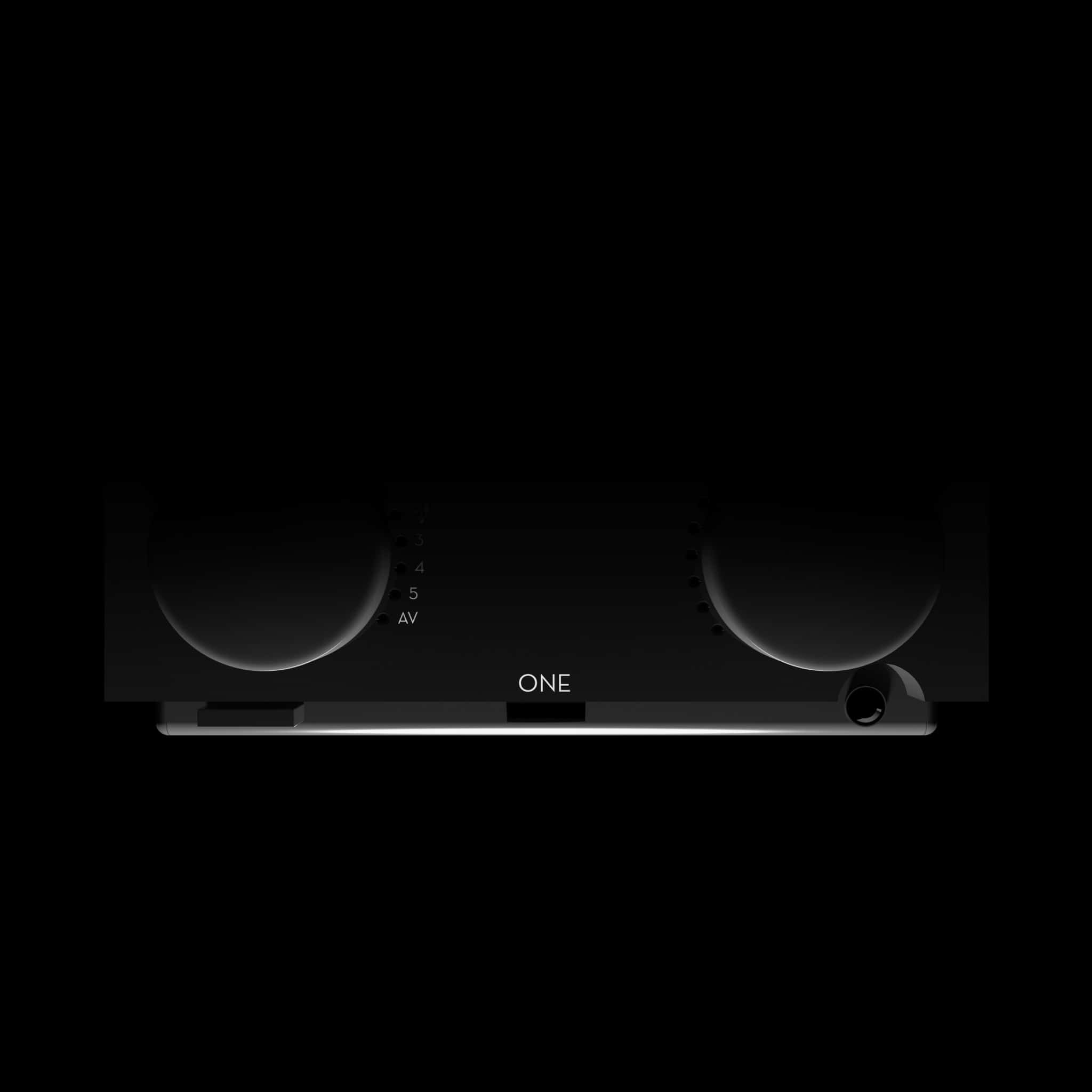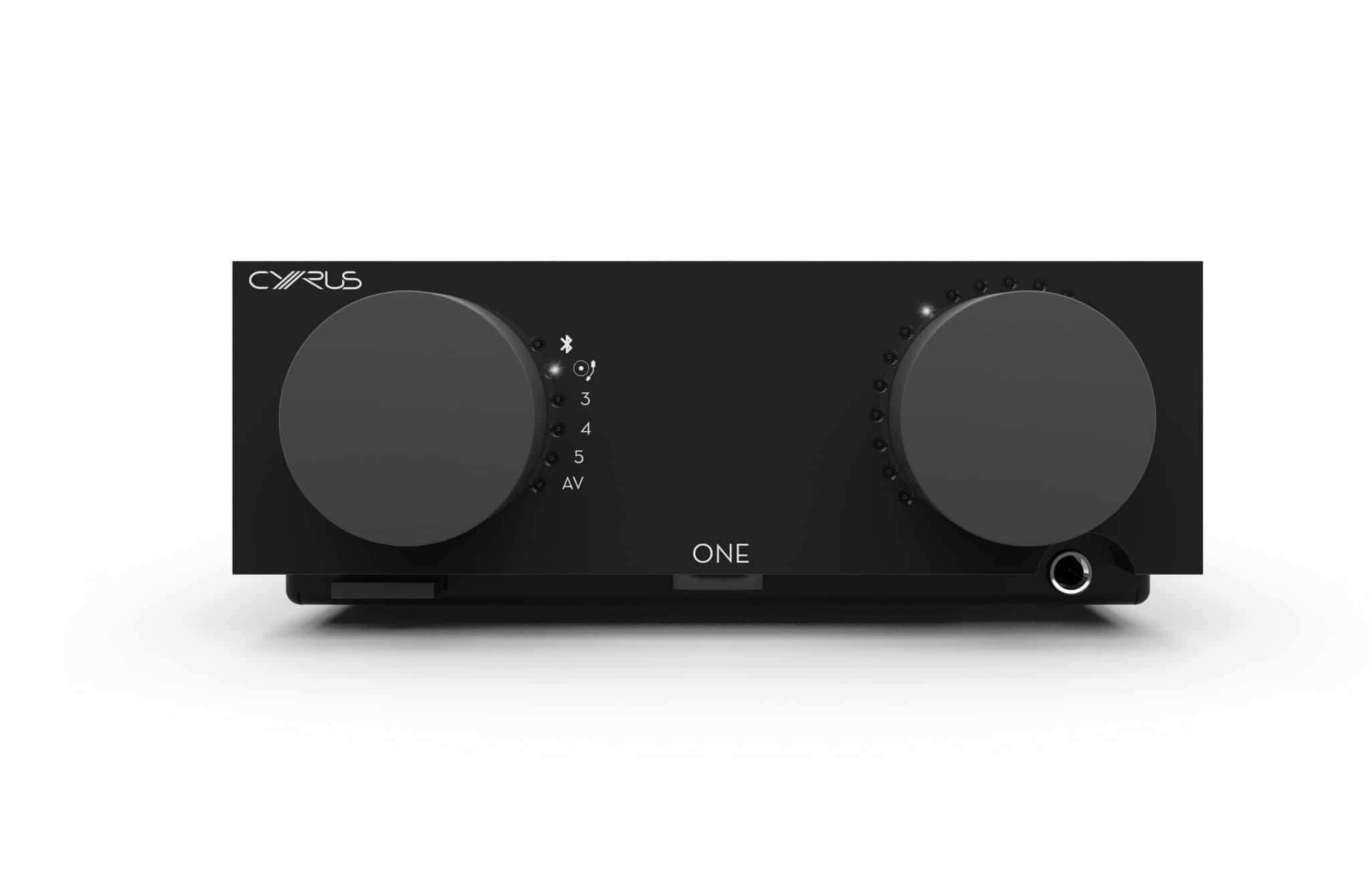The Article
Cyrus ONE integrated amplifier. Yes, it is a Cyrus. No, really.
21st October 2016

Entering the packed and competitive sub-£1,000 integrated amplifier arena, Paul Rigby reviews the Cyrus ONE
The ONE is more than an amplifier, at least to me. It’s the beginning of a new era. It brings hope and it establishes a statement of intent. And, frankly, it’s about bloody time.
For a long time – far too long – I have been reviewing Cyrus hardware wrapped in an outmoded, old fashioned and clunky chassis with an interface that only Sinclair Spectrum 8-bit computer fans would admit to loving.
The design looked like a novelty that stayed for the week-end but moved in for years, lacking style and panache and giving the Cyrus brand a stale, outmoded and dated look while the interface was hard to see, featuring a sickly green screen displaying blocky text and numerals that appeared to be a failed ‘join the dots’ puzzle book project. It got to the point where I believed Cyrus was in big trouble and I expected to receive an email saying that the company had died. The whiff of decay was in the air. Now? There is energy, there is vitality, there is life!
This new 100W Class D design is more than a refresh, it welcomes Cyrus into the 21st century. It modernises the design, offers a sleek yet confident chassis and removes, completely, the read-out. The ONE doesn’t need it.
There has been some comment about the brief light show that occurs when the ONE is powered up. Don’t be mislead here. It’s too brief to matter and is of no consequence in terms of you, the user. What it does highlight, though is the large source selector on the left and the volume knob on the right. Dimmable lights surround each to focus on the correct setting while an unobtrusive power switch lies on the bottom left.
Another aspect of the ONE’s design is the lack of the usual DAC. Current product launches seem to reflect a certain panic-stricken effort to pack as much into boxes as possible for fear of lagging behind in terms of connectable source devices and possible accusations of a lack of value for money. As far as I’m concerned, the more you pack into a small box, the greater the chance of increasing the noise floor. No featured DAC? Good. I’m a happy reviewer.
What is included is aptX-powered Bluetooth, an AV bypass mode to give it power amp facilities in a home cinema plus a built-in phono amplifier for turntables. A headphone socket sits on the front fascia too. The rear also reveals three extra pairs of RCA inputs, a second set of speaker connections and a mini-USB connection for software upgrades.
The rear plate design is not as well done as, for example, Heed’s similarly priced integrated amplifier, the Elixir. The ONE is a touch crowded which means that the more cables you insert into the rear, the more fiddly the task will be. The only other issue is the tiny remote control. This accessory feels rather cheap and nasty and is so small, that it is prone to loss. That said, it does the job and works without any issues.
SOUND QUALITY
I began with a slice of jazz on CD and Lou Donaldson’s Three Little Words from the 1959 Blue Note album, LD + 3 also starring Gene Harris, Andrew Simpkins and Bill Dowdy with Donaldson blowing a storm on Bird-infused sax.
At this price point, I’m used to how integrated amplifiers ‘sound’ and they sound that way because of budget limitations. The best designs are open and spacious, allowing the music to breath and the Cyrus does that too. Where the Cyrus moves onwards from that point – and this is absolutely crucial in terms of the essence of the ONE and its overall personality – is the focus. Where this track, from some of the better quality competition, can sound open and airy but also lacking in precision and accuracy, the Cyrus corrects those issues. Without that focus, the frequencies can often sound like a cloud of music, spreading sound haphazardly, smearing it all all over the soundstage. That is, you get an idea where the sound is coming from but if I gave you a pointer and asked you precisely from where, you’d give me 15 generalised areas. You’d be right, in a broad sweeping way but the Cyrus allows you to take that imaginary pointer and to dig right into the space and say “There!”
The ONE’s focus and accuracy is a wondrous element of its sonic personality but that has to derive from attention to detail in terms of low noise planning for both part selection and internal planning which allows other, more subtle, frequencies to do their thing. For example, the solo piano (a terribly chaotic instrument in terms of frequency presentation) is right on the money here. The focus and precision allows you to hear more from the piano because unruly notes and frequencies are no longer busy masking others. Hence, notes start and stop quicker which means that the piano now has a new lease of life, an increase in tempo and an injection of vigour. The same can be said of the drums and cymbals which benefit from the same focus.
One additional feature that I appreciated on this jazz piece was the bass. Again, at this price point, it is not unusual for jazz bass to be heard more as a tone only. Something that exists but you never really pin-point as an instrument. The Cyrus changes that too. There is more bass here, yes, but also there is a greater degree of character and form from this area so that you can better hear the upright bass as an entity in itself.
I then moved onto vinyl using an external phono amp and played Ian Dury’s Superman’s Big Sister via the LP, Laughter from 1980.
Again, the ONE came through with flying colours. The core of the track is the big, relentless bass beat that drives the rocking point home. This beat was tight, punch and hefty but also clear and distinct, allowing subtle frequencies to emerge from its left and right. This meant that secondary percussion had a free and airy aspect while the piano seemed to occupy its own space, allowing the ear to hear a distinctly honky-tonk flavour to the keys.
Dury’s vocal delivery was also focused with a delivery that was, if anything, rather naughty. Partly because it featured the man’s trademark delivery with a ‘twinkle’ but also because his own delivery started and ended precisely, hence his voice ‘danced’ over the soundstage.
Next, I played the same track but, this time, via the ONE’s own, internally mounted, phono amp. I was surprised at how good this unit was. In terms of sheer punch, the ONE was effective and strong. Yes, the internal unit loses out in terms of midrange insight and detail compared to quality external phono amplifiers (no surprise there) but the ONE is right up there in quality terms. There is enough instrumental separation within the broad soundstage to offer an ‘at ease’ presentation while enough clarity is maintained to give the sound an essential musicality while remaining informative.
For Bluetooth? Well, it was a bit of a relief, really. I’m getting used to struggling with this increasingly popular and numerous feature, which seems to be attached to everything from amplifiers, turntables, CD players to cups of tea and fluffy bunny rabbits. The problem I tend to have is the pairing operation which can be relatively drawn out while the target unit sometimes finds it difficult to find my music source. Not here. I alerted my iPhone 6S to Bluetooth and, bang!, there was the Cyrus, no messing. Straight away it appeared on my Bluetooth list. One touch and it was active. Smooth and sweet. The playback was impressive too on both Coldplay’s Clocks plus Nina Simone’s Feeling Good. The main reason was the enhanced lower frequencies that never dominated but added enough body and weight to fool the brain into thinking that this pathetic MP3 file was actually pretty good. It’s a nice trick and its appreciated. Yes, the midrange remains weedy and lacking in…well, most things actually but the Cyrus offers the MP3 music a sense of style.
CONCLUSION
Compact in size but offering a snazzy and very attractive sense of dash and urbanity, the ONE provides everything you might need within a budget amplifier without any sense of compromise. The low noise focus that the amplifier bestows upon the musical output is very impressive making it a hard challenger for amplifiers double the price. The internal phono amp is a nice addition while the ONE’s implementation of Bluetooth is refreshing. Easy to use, it will be even easier to buy. This is a quality unit and anyone looking to build a budget system would be foolish to ignore it.
CYRUS ONE INTEGRATED AMPLIFIER
Price: £699
Tel: 01480 410 900
Web: www.cyrusaudio.com
GOOD: focus, midrange precision, bass control, design, Bluetooth
BAD: nothing at the price
RATING: 9
REFERENCE SYSTEM
Rega RP3
Russ Andrews RP3 power unit
Trichord Dino Mk.3 phono amplifier
Leema Essentials CD player
Rega Brio-R integrated amplifier
Heed Elixir amplifier
Q Acoustics 3020 speakers







Hi Paul, apart from Bluetooth – how does this stack up against the new Brio R 2917??
Hi Fred, I have yet to test the new Brio version but will endeavour to grab one for a review.
Thanks for the quick reply..I plan to check them out this Friday…I have a Rega RP40, so suspect the Brio might be a best fit. Though I am also planning to get some speakers to replace my ageing Tangent RS4’s!! So a few things to juggle:-)
how does this stack up against the Quad Vena in your opinion ?
The Vena is big, punchy, controlled but I wouldn’t go there if you value a delicate element in your music presentation. The ONE is preferable in that area.
delicate presentation would win me over every time. i better go and have an audition …
thanks for the reply paul !
How does this amp compare to the Audiolab M ONE ?
Well, in terms of facilities, the Audiolab gives you a DAC, both have Bluetooth. In terms of sound? Both are recommended in sound terms. If push comes to shove? The Audiolab offers less ‘oomph’, I prefer the Cyrus’ insight in terms of upper mids and treble.
Thanks for the reply, one last question do you think the Q Acoustics 3020 would be a good match for the Cyrus ?
Paul
nice, informative and balanced review. I’ve got an old but still great pair of mission 753 floor standers. I’m thinking of Cyrus One, and a new CD and TT
would i be advised to plum for Cyrus Cd transport and DAC or CD i (anything else?) and a £600 ish TT Рany recommendations would be greatly received in this minefield of HIFI info overload.
i simply want great sound from CD and Vinyl and nothing else bothers me
kind regards
Craig
Thanks for your comments Craig. As for the turntable? I’d plump for the Rega Planar 3 at around ¬£550. What’s your CD/DAC/etc budget? In terms of sonics, splitting the CD player into a transport and DAC is sonically superior but often more expensive. Hence the budget question. Another option, though, and one to be seriously considered, although it does require a bit more effort, is to carefully rip each CD you want to play using a quality ripper, copying that to a mini-SD card and inserting that into a solid state-run digital music player which you plug directly into your amp. Doing it this way removes jitter and transport noise.
Thank you for such a thorough review. How would you compare this Cyrus to the bel canto c5i?
I’d lean towards the Cyrus as the C5i is a little warm in presentation for my tastes. I prefer a more neutral sound but you may like the bass approach.
Thank you for your prompt reply. And according to your assessment I would prefer the warmer sound…so the C5i it will be. Though the Cyrus was pretty nice.
I have Audiolab m one driving q acoustics 3020 and thinking of buing Cyrus one. Would this be any “progress”. What can I expect?
Yes but it might be better in value terms to aim one rung higher and look at amps up in the £1300 or so area.
Hi Paul,
I’m struggling between Cyrus one and Audiolab 6000A.
Have any suggestions for me?
Thanks!
I like both, to be honest. I could live with either. If pushed I’d go with the 6000A but if you find a good deal…?